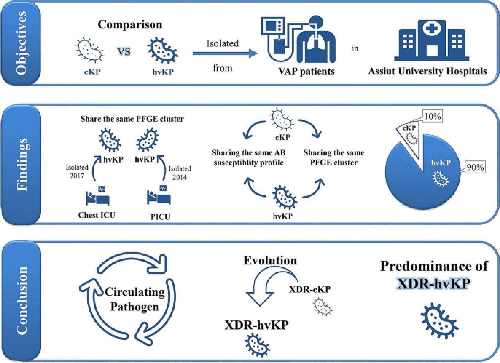
Full text loading...

Emergence of XDR-hvKP as the predominant
K. pneumoniae
pathotype responsible for ventilator associated pneumonia in Assiut, Egypt.
Introduction. Hypervirulent-K. pneumoniae (hvKP) is an evolving pathotype that is more virulent than the classical- K. pneumoniae (cKP) and causes serious fatal illnesses.
Hypothesis/Gap Statement. Although there are few reports on hvKP isolated from Egyptian patients, the molecular characteristics and clonal relatedness of MDR-hvKP have not been adequately investigated.
Aim. To investigate the microbiological and genetic characteristics as well as the epidemiology of hvKP induced ventilator-associated pneumonia (VAP).
Methodology. A retrospective study of 59 K . pneumoniae inducing VAP was conducted at Assiut University Hospitals from November 2017 to January 2019. All K. pneumoniae were tested for resistance phenotype, capsular genotype (K1 and K2), virulence gene profile (c-rmpA, p-rmpA, iucA, kfu, iroB, iroN), and the presence of resistance genes (blaNDM-1, blaCTX-M-3-like, blaCTX-M-14-like). Clonal relatedness was assessed by Pulsed field gel electrophoresis (PFGE).
Result. HvKP accounted for 89.8 % (53/59) of K. pneumoniae isolates with ~95 % exhibiting extensively-drug resistant (XDR) phenotype. Hypermucoviscous phenotype was detected in 19 (35.8 %) hvKP and K2 capsular gene was identified in 18 (33.9 %) of hvKP. Regarding the virulence genotype of hvKP strains, iucA was the most prevalent virulence gene (98.1%), while p-rmpA and kfu were detected in 75.4 and 52.8 % of hvKP strains, respectively. Resistance genes were highly prevalent in both cKP and hvKP with blaCTX-M-3-like being more prevalent in hvKP (100 % vs 94.3 % for blaNDM-1, 50 % vs 62.2 % for blaCTX-M-3- like and 83.3 % vs 69.8 % for blaCTX-M-14 -like, respectively). PFGE typing of 29 representative K. pneumoniae revealed 15 pulsotypes, with identical hvKP pulsotypes isolated from different ICUs at different times and several hvKP and cKP isolates belonged to the same pulsotype.
Conclusion. This study highlights the dominance and clonal spread of XDR-hvKP strains at Assiut University Hospital in Egypt. Physicians should be aware of the increased risk of hvKP induced-VAP and support further epidemiologic studies.

Article metrics loading...

Full text loading...
References


Data & Media loading...
